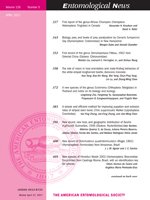The roles of vision in host orientation and mate finding were investigated in a major coleopteran pest of broad-leaved plants, the white-striped longhorned beetle Batocera lineolata, in the laboratory. Adults oriented strongly to host-related wavelengths (560–600 nm), and preferred different target wavelengths under different light sources (artificial light and natural light). The combined effect of color and volatile organic compounds from host plants were significantly attractive to B. lineolata adults (P<0.05). Blinded adults could find mates by olfaction alone, but needed more time (P<0.05). Our findings will help to understand visual and volatile attraction in this longhorned beetle and may present potential novel approaches for sustainable management.
How to translate text using browser tools
1 April 2017
The Role of Vision in Host-Orientation and Mate-Finding Behaviors of the White-Striped Longhorned Beetle, Batocera lineolata
Hua Yang,
Bao-Xin Wang,
Wei Yang,
Chun-Ping Yang,
Lin Lu,
Zhang-Ming Chen
ACCESS THE FULL ARTICLE

Entomological News
Vol. 126 • No. 5
April 2017
Vol. 126 • No. 5
April 2017
Batocera lineolata Chevrolat
host color
host orientation
mate finding
olfaction
vision




